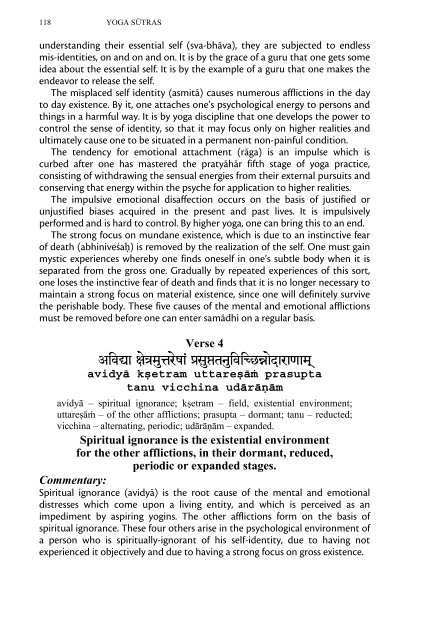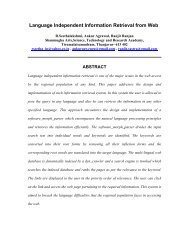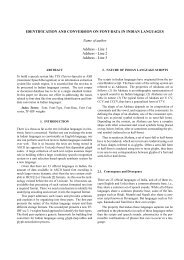You also want an ePaper? Increase the reach of your titles
YUMPU automatically turns print PDFs into web optimized ePapers that Google loves.
118 YOGA SŪTRAS<br />
understanding their essential self (sva-bhāva), they are subjected to endless<br />
mis-identities, on and on and on. It is by the grace of a guru that one gets some<br />
idea about the essential self. It is by the example of a guru that one makes the<br />
endeavor to release the self.<br />
The misplaced self identity (asmitā) causes numerous afflictions in the day<br />
to day existence. By it, one attaches one’s psychological energy to persons and<br />
things in a harmful way. It is by yoga discipline that one develops the power to<br />
control the sense of identity, so that it may focus only on higher realities and<br />
ultimately cause one to be situated in a permanent non-painful condition.<br />
The tendency for emotional attachment (rāga) is an impulse which is<br />
curbed after one has mastered the pratyāhār fifth stage of yoga practice,<br />
consisting of withdrawing the sensual energies from their external pursuits and<br />
conserving that energy within the psyche for application to higher realities.<br />
The impulsive emotional disaffection occurs on the basis of justified or<br />
unjustified biases acquired in the present and past lives. It is impulsively<br />
performed and is hard to control. By higher yoga, one can bring this to an end.<br />
The strong focus on mundane existence, which is due to an instinctive fear<br />
of death (abhiniveśaḥ) is removed by the realization of the self. One must gain<br />
mystic experiences whereby one finds oneself in one’s subtle body when it is<br />
separated from the gross one. Gradually by repeated experiences of this sort,<br />
one loses the instinctive fear of death and finds that it is no longer necessary to<br />
maintain a strong focus on material existence, since one will definitely survive<br />
the perishable body. These five causes of the mental and emotional afflictions<br />
must be removed before one can enter samādhi on a regular basis.<br />
Verse 4<br />
Aiv*a ]eÇmuÄre;a< àsuÝtnuiviCDÚaedara[am!<br />
avidyā kṣetram uttareṣāṁ prasupta<br />
tanu vicchina udārāṇām<br />
avidyā – spiritual ignorance; kṣetram – field, existential environment;<br />
uttareṣāṁ – of the other afflictions; prasupta – dormant; tanu – reducted;<br />
vicchina – alternating, periodic; udārāṇām – expanded.<br />
Spiritual ignorance is the existential environment<br />
for the other afflictions, in their dormant, reduced,<br />
periodic or expanded stages.<br />
Commentary:<br />
Spiritual ignorance (avidyā) is the root cause of the mental and emotional<br />
distresses which come upon a living entity, and which is perceived as an<br />
impediment by aspiring yogins. The other afflictions form on the basis of<br />
spiritual ignorance. These four others arise in the psychological environment of<br />
a person who is spiritually-ignorant of his self-identity, due to having not<br />
experienced it objectively and due to having a strong focus on gross existence.










